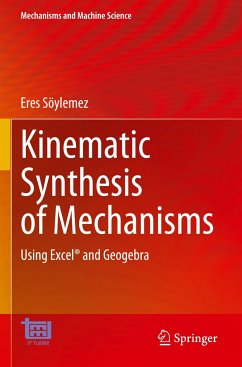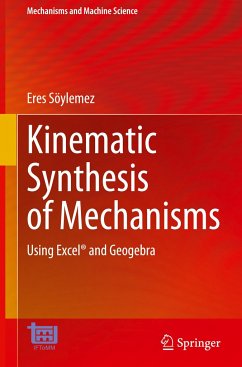
Mechanisms-Synthesis and Analysis with Applications in Robotics

PAYBACK Punkte
38 °P sammeln!
This book serves as an introductory course on mechanisms with robotics concepts for undergraduate students. New concepts are presented that support the mechanical design of robots. Basic concepts from mechanism theory are presented to provide a base for designing mechanisms in general.Part I of the book examines the introductory concepts of mechanisms theory and serves as basis for analyzing and designing mechanisms. Part II presents the analysis of four-bar linkages, including the Grashof criterion and the transmission quality; structural analysis of mechanisms, including concepts used in rob...
This book serves as an introductory course on mechanisms with robotics concepts for undergraduate students. New concepts are presented that support the mechanical design of robots. Basic concepts from mechanism theory are presented to provide a base for designing mechanisms in general.
Part I of the book examines the introductory concepts of mechanisms theory and serves as basis for analyzing and designing mechanisms. Part II presents the analysis of four-bar linkages, including the Grashof criterion and the transmission quality; structural analysis of mechanisms, including concepts used in robot design such as connectivity and redundancy; and kinematic analysis of mechanisms, including analysis of position, velocity, and acceleration. Part III describes the number and type syntheses of mechanisms; dimensional synthesis of four-bar linkages for two and three positions; dimensional synthesis for function generation and crank-rocker mechanism.
Chapter-wise teaching examples are shown, and specific references for each topic are listed. At the end of each chapter, a list of exercises with gradually increasing difficulty is presented, designed to help undergraduate students understand the contents.
Part I of the book examines the introductory concepts of mechanisms theory and serves as basis for analyzing and designing mechanisms. Part II presents the analysis of four-bar linkages, including the Grashof criterion and the transmission quality; structural analysis of mechanisms, including concepts used in robot design such as connectivity and redundancy; and kinematic analysis of mechanisms, including analysis of position, velocity, and acceleration. Part III describes the number and type syntheses of mechanisms; dimensional synthesis of four-bar linkages for two and three positions; dimensional synthesis for function generation and crank-rocker mechanism.
Chapter-wise teaching examples are shown, and specific references for each topic are listed. At the end of each chapter, a list of exercises with gradually increasing difficulty is presented, designed to help undergraduate students understand the contents.












